Daffodils, also known as narcissus, get their name from the Greek myth that tells the story of Narcissus, who was overcome by such vanity that he spent his entire life looking at his reflection in a pool of water, according to Truly Experiences. When he died, legend has it that daffodils began to grow in his place. However, others believe that the origin of the daffodil is not directly related to the myth of Narcissus. The word narcissus comes from the Greek word for numbness, which can be attributed to a daffodil’s heady scent, as per The New York Botanical Garden. Alternatively, “numbness” may refer to the toxicity of the daffodil when ingested.
Regardless of the true origin story of the daffodil, this plant has made its way all over the world and is a popular and deliciously scented flower that signifies the start of the growing season. When provided with the preferred growing conditions, this flower is easy to care for and will reward you with blooms every spring. You will likely recognize the sunny yellow hue of the daffodil, but the blooms also come in white, pink, and orange. The size of the daffodil plant and flower will depend on the species but can range from 6 to 30 inches in height and 6 to 12 inches in width, per The Spruce. If you’re ready to start planting, the following guide will teach you all you need to know about growing and caring for daffodils in your garden.
How to use daffodils in garden
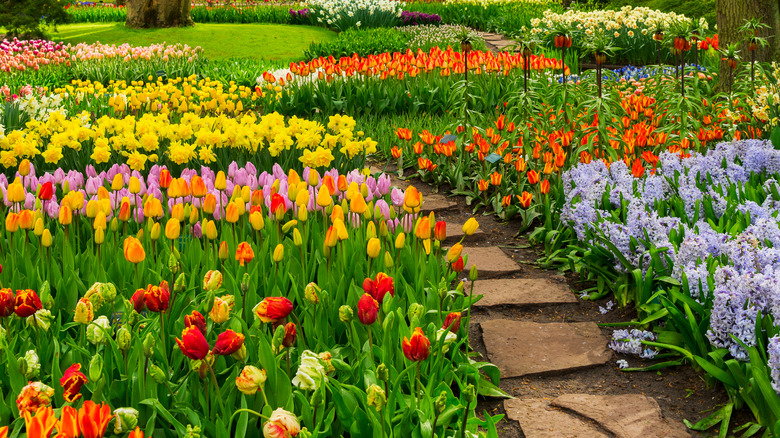
Daffodils are the perfect flower to add to your garden to provide it with gorgeous pops of color. While daffodils can be planted in containers or in beds, containers will need to be brought indoors during the winter, depending on the region you live in, as per Dutch Grown. If this isn’t a problem, containers can provide a great way to display your daffodils in your garden or on a patio or deck come spring.
Since daffodil blooms are often the first to come up in the early spring, you can use this to your advantage when planning the layout of your garden. For example, you can scatter daffodils among the garden beds in your yard, rather than planting them in their own bed, to enjoy a tapestry of color before the other perennial flowers start blooming. You may also want to consider planting daffodils with other plants of similar height to avoid any one flower taking over another’s visual space.
This flower grows well under most trees, with the exception of evergreens, according to High Country Gardens. For this reason, you can plant daffodils in a cluster around the base of the trees in your garden to provide a focal point of color. Another popular location to plant daffodils is along foot pathways. As you pass through your garden, you’ll be greeted by the intoxicating scent of the blooms.
How to grow daffodils
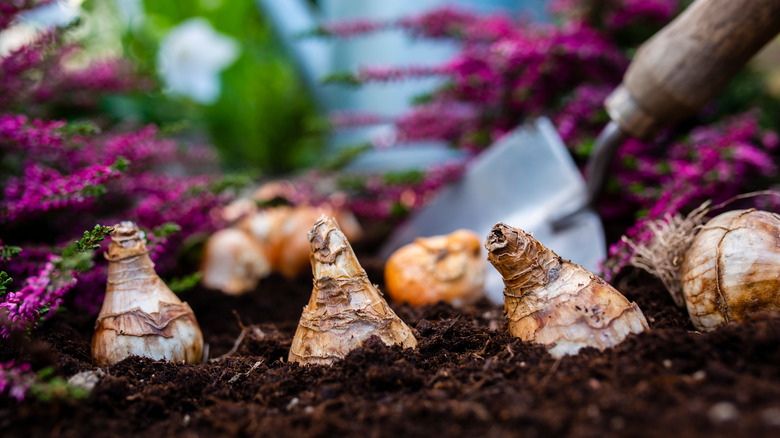
Daffodils grow best from bulbs, which will need to be planted long before the growing season begins, ideally in the late fall when temperatures begin to drop, according to Dutch Grown. This allows the roots to develop deep within the soil, which in turn gives the plant the best shot at survival come spring. Once you’ve chosen a location in your garden to plant your daffodil bulbs, all you’ll need is a trowel and a pair of gardening gloves.
You’ll first dig a hole at least three times the length of the bulb to ensure the bulb is protected from temperatures and weather aboveground during its rooting season. The bulb should be placed with the pointed end facing upward. The final step is to fill in the hole with soil and water generously. Once you have the first hole dug, make sure to leave around 5 inches of space between subsequent holes.
If you’ve chosen to plant your bulbs in a container, follow the same steps as planting in your garden, using a combination of sandy soil and potting soil, as per Dutch Grown. The container should be at least a foot deep and will need to be placed in a cool and dry indoor location until the end of winter. The great news about growing daffodils is that you won’t need to do anything once you’ve planted and watered the bulbs. The plant will do all the work on its own between fall and spring.
How to care for daffodils
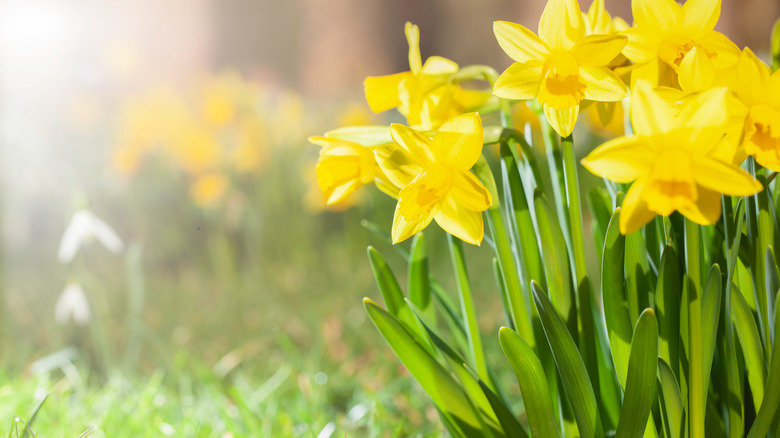
Simon Bratt/Shutterstock
Daffodils are a breeze to care for when provided with their preferred growing conditions. This means full to partial sun throughout the day, well-draining soil that is not overwatered, and low humidity, according to The Spruce. If you live within USDA hardiness zones 4 to 8, your daffodils will assuredly thrive. Once spring comes and you notice that the daffodils have begun sprouting, you can water on a regular basis, taking care to monitor the saturation of the soil. Soggy soil will cause the plant to rot while underwatering will also ensure your daffodils die off. If you live in an area with regular rainfall, you may not need to water the flowers at all. Your daffodils will also thank you for checking the soil’s acidity level throughout the growing season — it should never exceed a pH of 6.0.
If water and soil conditions are met, you’ll also want to sprinkle a bit of fertilizer around the new sprouts come spring to ensure they have the nutrition they need for the entire length of the growing period. Additional fertilizer shouldn’t be required. You can also help your daffodils thrive by cutting back yellowed and dying leaves.
After blooming for around six weeks, the flowers will die off and growth will cease. You’ll want to stop watering at this point and allow the plant to go dormant once more. It will automatically come back the following spring.
Varieties of daffodils
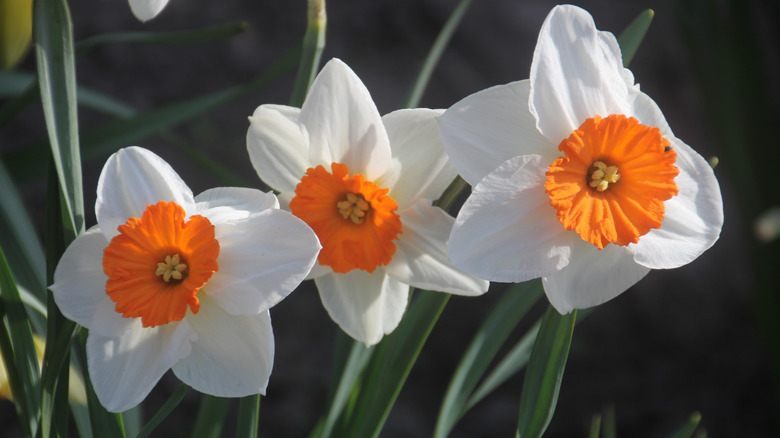
Kovalyk Artur/Shutterstock
Daffodils come in a variety of species, although botanists dispute the exact number, making it anywhere between 40 and 200, according to Here By Design. All are native to northern Europe. Within the varieties of daffodils, you will find them divided into a total of 13 categories based on the appearance of their blooms. A few of the divisions include trumpet, doubles, triandrus, jonquils, poeticus, small-cupped, and large-cupped. The daffodil blooms can be found in a variety of colors in addition to the more popular yellow. The color can also differ between the petals and the center, offering beautiful contrasts that will liven any outdoor space.
Among the yellow blooms is the Tahiti daffodil, which grows between 12 and 18 inches in height and features various layers of light-yellow petals with a bright-orange accent toward the center, as per The Spruce. The Sir Winston Churchill daffodil features a beautiful white bloom with a gold center, and is similar to the Tahiti daffodil in that it also belongs to the double-petaled division. For a stunning white and pink bloom, look no farther than the Petit Four daffodil, which is marked by a single layer of outer white petals and a frilly rose interior. The Professor Einstein daffodil has pointed white petals and an interior orange cup that frames the yellow stamen. This flower is known for its extra-sweet scent. One last variety you might consider for your garden is the delicate Poet’s daffodil with its large white petals.
Are daffodils toxic?
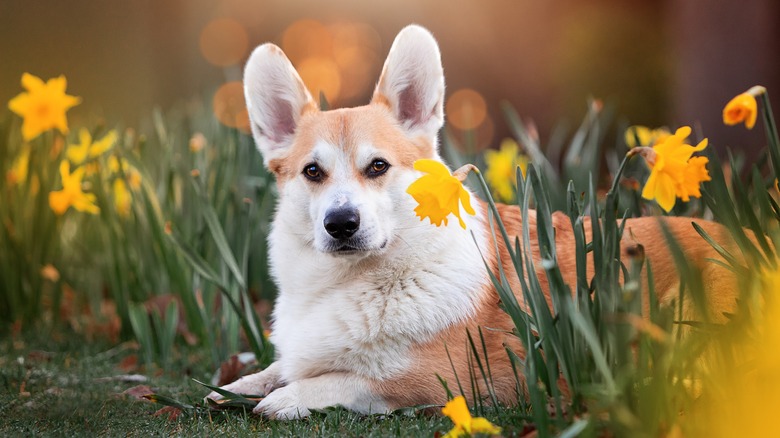
Defodi Images/Getty Images
In short, daffodils are incredibly toxic and should never be ingested by humans or animals, as per SF Gate. All parts of the plant contain lycorine and calcium oxalate crystals, both of which are poisonous chemicals that the plant uses to protect itself. If you have wild animal visitors to your yard, you’ll notice that they will naturally avoid munching on daffodil blooms. Accidental ingestion can cause a variety of issues in the digestive tract, including vomiting, diarrhea, general stomach pain, convulsions, and cardiac arrhythmias.
Some people experience skin reactions when touching daffodils as well. While easy to treat with water and soap, it is best to avoid this problem entirely through the use of gloves. If you or anyone in your family has ingested any part of the daffodil plant, head to the nearest emergency room for immediate assistance. In the case of your pet, consult with your closest emergency veterinary hospital and/or a poison helpline.
The best way to avoid daffodil poisoning is to prevent it from the get-go. This may mean fencing off areas of your yard where the daffodil plant grows to prevent small children and pets from having access. You may also need to train your pets to stay away from daffodils through positive reinforcement or deter them completely through the use of bitter sprays. If all else fails, growing daffodils in containers may be an option that allows you to keep the plant off the ground and out of reach.
How to repot daffodils
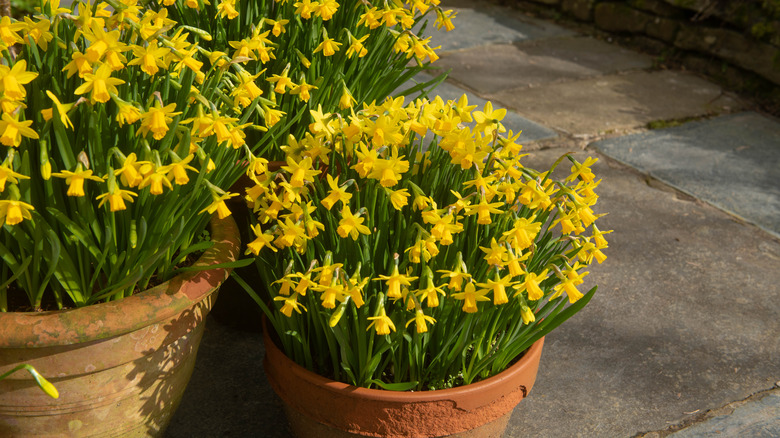
Peter Turner Photography/Shutterstock
Repotting daffodils will be similar to the original potting process. While daffodils can stay healthy in a container for up to three years, it’s best practice to replace the bulbs every fall and change out the soil. Unlike many other plants, you likely won’t have to upgrade your container or pot unless you planted too many daffodils the year before and found that the container became overcrowded. To get started with the repotting process, you will need to remove the dead growth and bulbs and dump out the soil. Note that your old bulbs don’t have to go to waste — just plant them in your garden.
With an empty pot in front of you, The Spruce instructs gardeners to first provide a layer of potting soil in the base of the container. You will then place new bulbs in the bed of soil with the pointed end facing up. The tip of the bulb should also not exceed the lip of the container to ensure the entire bulb gets covered with soil. You can place bulbs near one another in a container, but never touching. Once the bulbs are situated in the pot, fill in the rest of the container with soil to just below the top. At this point, you’ll need to give the bulbs a generous drink of water before leaving them in a cool indoor location until the end of winter. Once growth begins, you can move outside and resume watering.
Daffodil pests and diseases
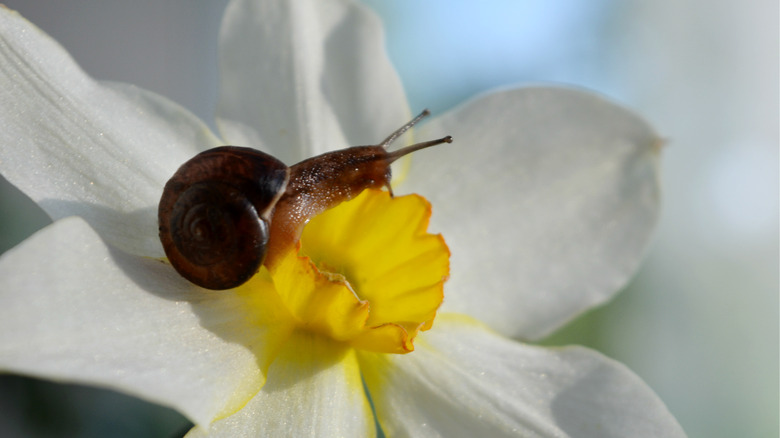
Alex2016/Shutterstock
Daffodils are susceptible to a number of diseases and pests that can cause extensive injury and even death. The Daffodil Society points out that snails and slugs can be problematic to the health and longevity of your daffodils in that they eat the flowers and foliage, destroying the beautiful blooms. They can also pass along viruses and infectious bacteria to your daffodils. Another common daffodil pest is the large narcissus fly, which lays eggs at the base of the daffodil plant. The resulting larvae eat through the bulb where they finish maturing before flying away. This practice can destroy the daffodil plant at its core and is best prevented through getting rid of infected bulbs and laying a mesh cover over the soil throughout the plant’s dormant period.
The most common disease that affects daffodils is fungal rot, which can come in various forms. The most common, basal rot, affects the bulb of the plant, which is caused by heat in the summertime. A fungicide can help control the situation once it starts, but infected bulbs will need to be removed and disposed of. Viral diseases can also be spread to daffodils through insect pests, such as nematodes. The yellow stripe virus and cucumber mosaic virus are two common viruses that destroy the daffodil plant. You can prevent this by making sure your daffodils aren’t stressed in their growing environment and through pesticide sprays and/or hot water treatments, depending on the type of pest.



